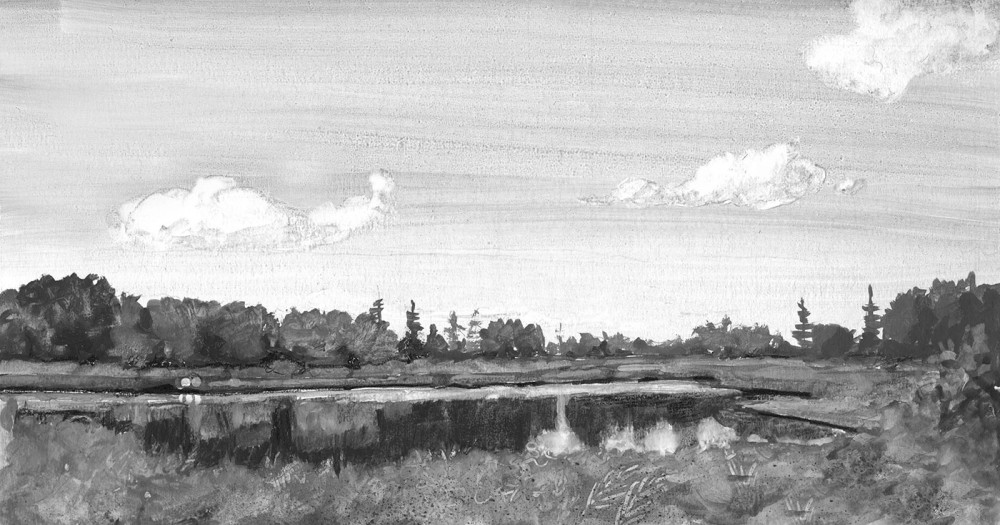
“Squish, squash.” I was walking gingerly on a soft, spongy carpet of sphagnum moss in a northern Vermont bog. Magenta blossoms decorated the sheep laurel shrubs that lined the edge of the open wetland – beyond them the pointed spires of balsam fir and black spruce reached towards the sky. Ahead of me, the white tufts at the ends of cotton grass waved in the breeze. I took another step. There was a sucking sound, and a cold, wet feeling as my right foot suddenly sank a couple of feet into the bog. It was challenging to get it out without falling in entirely, but I finally extricated my muddy boot and vowed to buy some high rubber boots for future wetland exploration.
This bog had formed in a depression surrounded by ridges, a kettle hole where a chunk of ice had remained after the glacier retreated. When the ice block melted, it left a pond sealed by a clay bottom. Over millennia, the remains of plants and animals had filled in the pond, but because of the acidic, anaerobic (low in oxygen) environment, they had only partially decomposed, forming peat. The peat provided a surface for other plants to grow on, and their interlacing roots had created a mat over the bog, which in the center was floating on water. A bog mat is similar to a “saturated sponge sitting in a sink of dishwater,” writes naturalist Charles Johnson in his book Bogs of the Northeast. Since the mat is permanently saturated with acidic water, decomposition slows, causing more peat to accumulate.
Like most bogs, the bog I explored has no inlet or outlet and receives almost all of its water and nutrients from precipitation. Only plants adapted to a nutrient-poor environment can grow here, making the bog a different world from the surrounding forest. Shrubs in the heath family such as leatherleaf, bog rosemary, and Labrador tea (whose fuzzy leaves were brewed for tea by native Americans) specialize in the acidic conditions that are common in bogs. Carnivorous pitcher plants, sundews, and bladderworts obtain additional nutrients by trapping and digesting insects.
Fens are another type of wetland often mistaken for bogs. Like bogs, they have a saturated peat mat. But because they receive inputs of mineral and nutrient-rich water from springs or seasonal streams, fens are more alkaline than bogs, and support different, more diverse vegetation. The first fen I visited looked like a wet lawn that hadn’t been mown for a while. It was covered with sedges, grasses, and non-sphagnum mosses and dotted with hundreds of pink and white showy lady’s slippers in bloom.
According to Johnson, there is a continuum of peatland types between bogs and fens, depending on the water sources, the amount of minerals and nutrients carried in, and temperature and precipitation patterns, particularly the timing of wetting and drying. Those fens that overlie calcareous bedrock such as limestone and receive a regular inflow of calcium-laden groundwater are hotspots of botanical diversity and are called rich fens. Rare orchids and other uncommon plants may grow here.
Many animals, including spruce grouse, black-backed woodpeckers, palm warblers, bog lemmings, and red-backed voles, spend part of their lives in bogs and fens. Some insects, like the colorful bog fritillary and tiny bog elfin butterflies, depend on these habitats because their larvae feed on bog vegetation. Dragonflies, including the rare ebony bog haunter, also frequent bogs.
Because they are unusual natural communities, a number of bogs and fens in our region have been conserved. Some are open to the public and have had boardwalks installed to make them more accessible and to discourage people from walking on (and possibly falling through) the bog mat.
In Vermont, Moose Bog in the Wenlock Wildlife Management Area near Island Pond and The Nature Conservancy’s Chickering Bog (actually a fen) in Calais both have boardwalks. New Hampshire Audubon’s Ponemah Bog (a poor fen) near Nashua and two bogs in the Pondicherry Wildlife Refuge near Jefferson are also good places to experience the wonder of peatlands.


Discussion *